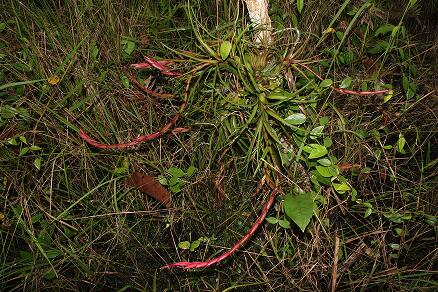Family: Bromeliaceae

Kingdom: Plantae Rank: Family Parent: Poales Status: Valid
Common Names:
- Bromeliaceae - English, United States of America
Morphological Description
Diagnosis: Epiphytes, some species terrestrial. Leaves thin to broadly lanceolate, sessile, basal, alternate, spiral, the margins spinose in many genera, the secondary veins parallel, sometimes inconspicuous. Infructescence terminal, in some genera as large or larger than the plant. Fruit a berry or capsule with tiny winged seeds. Many genera adapted to altitudes above 3500 m. Referred to as the "pineapple" family.
Vegetative Morphology
Habit: Herbs, usually epiphytic but sometimes terrestrial.
Leaves: Leaves simple, spirally arranged in rosettes, somewhat sheathing at base; the lamina often narrow, elongate, usually with peltate scales, the margins entire, serrate, or spinose.
Reproductive Morphology
Inflorescence: Inflorescence usually terminal, pedunculate or sessile, panicle, raceme, spike, or head, usually bearing conspicuous brightly colored bracts.
Flowers: Flowers bisexual, mostly actinomorphic; sepals and petals 3, free or fused; stamens 6 in 2 series of 3, filaments free or fused, sometimes adnate to petals; ovary superior or inferior, 3-locular, the styles 3-lobed.
Fruit: Fruits capsular or berry-like.
Seeds: Seeds few to numerous per fruit, winged, plumose, or naked.
Other
Uses: Valued as ornamental plants for indoor and outdoor tropical gardening. Variables of the distribution, abundance, and morphology of some species of Tillandsia have served as models for air quality monitoring research.
Distribution: Tropical America, with some species in subtropical regions to the north and south.
Ecology: Mostly herbs with aerial, epiphytic habitats, but some species terrestrial. Diverse and abundant in moist lowland, submontane, and montane cloud forests of Central and South America. Some species important as a food source for animals, such as the Andean Spectacled Bear, known to break bromeliad plants open to eat the soft stem base and new leaves. Numerous species of the Bromeliaceae are tank-forming, collecting rain water, which serves as habitat for aquatic arthropods and amphibian species.
Notes: Often referred to as the pineapple family.